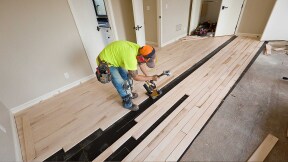Sustainable building materials: How to make your home more resilient

Within the ever-evolving landscape of green architecture lies the demand for more sustainable homes. While there are many ways to achieve this — sustainable energy sources like solar panels and energy-efficient smart homes, for example — there’s another simple solution to consider. The key? Going back to the basic building blocks — literally. Durable, sustainable building materials can help make our homes more comfortable while also becoming potential strongholds for sustainability.
What are sustainable building materials?
In construction, environmentally friendly materials (also known as green building materials) are ones whose production, usage and maintenance have been done through a sustainable lens. They must be durable, safe, reusable, recyclable or include recyclable materials in their composition. These materials may be natural, often made from substances like:
- Soil
- Adobe
- Wood
- Cork
- Bamboo
- Straw
- Sawdust
Most importantly, they must not be vulnerable to natural environmental conditions like cold, heat or humidity. Oftentimes, sustainable building materials have a low embodied energy content (the amount of energy required to produce the material), use local renewable energy sources or are made from materials that contribute fewer greenhouse gas emissions in the atmosphere.
What are the most sustainable building materials?
Now that you understand the importance of these building blocks and how they contribute to the eco-conscious nature of a home, you’re probably wondering what these materials are. Luckily, we live in a world where innovation knows no bounds, and there are multiple materials that may be sourced to help build sustainable homes, including:
- Cob: A blend of clay, sand and straw that can withstand extreme temperatures, cob is often used to help build walls, fireplaces, ovens, insulation and other foundational elements.
- Recycled steel: This material is known for its strength, durability and versatility. It is often recycled from scrap yards and demolition sites, among other spots, and used as a structural framework for many parts of a home.
- Sheep’s wool: Sheep’s wool is a recyclable, renewable and environmentally friendly source of raw material, which consists of 60% animal protein fibers, 10% fat, 15% moisture, 10% sheep sweat and 5% impurities on average. It’s often used to help insulate homes.
- Upcycled wood: Upcycling wood means taking wood waste and using it to make something else. Upcycled wood is often used as a sustainable material to help build furniture or flooring.
- Cork: Cork is a natural material derived from the bark of cork oak trees. You may have popped it out of a wine bottle or two. What you may not know is that cork is also used as a sustainable building material for flooring, walls and ceilings.
- Bamboo: Bamboo comes from bamboo plants and has been used in construction in Asia for thousands of years. It is now having a moment in Western culture as a sustainable building material. Bamboo is fast growing, incredibly strong and can be used to build the foundation of a home, among other things.
- Recycled plastic: Recycled plastic is another sustainable building material. Some green construction companies have been known to melt down plastic and turn it into hard bricks used to help build homes.
- Stone: Natural stone has been used as a building material since the dawn of time. It’s known to withstand weathering conditions and is often used internally and externally in the homebuilding process. For example, some homes sport stone walls or fireplaces as a decorative statement, while others may use the resource for more functional foundational purposes.
- Straw bales: Straw bales have been used as a natural building method across the world. Code-approved by almost every state in the U.S. in the International Residential Code (IRC), straw bale is often used to help support roof structures.
Examples of sustainable construction
Now that you know more about sustainable building materials, let’s discuss a few ways to apply them. There are sustainable ways to physically construct homes or specific home features that may be more sustainable than others. For example:
- Prefab modular construction: Prefabricated homes are partially manufactured in a factory. The pieces are then brought to their sites and put together to make the final home. Prefabricated homes are more methodical than traditional, stick-built homes and produce less waste.
- Smart appliances: Smart appliances are tech-savvy appliances that can help automate power sources throughout a home. For example, smart thermostats can control the temperature of a home automatically to ensure energy isn’t being wasted in cooling or heating.
- Cool roofs: Cool roofs are designed to reflect more sunlight than a conventional roof by absorbing less heat energy. This helps reduce the temperature of a building and may be particularly useful in warmer climates.
- Green insulation: Green insulation is the concept of using eco-friendly materials to help insulate a home: for example, using sheep’s wool in between the foundation of a home and the walls to help warm the home in colder weather.
- Solar power: Solar power uses the sun to help produce electricity instead of using less sustainable methods like burning fossil fuels. Solar power is often produced by installing solar panels on the roofs of homes.
In summary
Sustainable building materials help build homes that not only withstand the test of time but also leave a minimal environmental footprint. Embracing sustainable building materials during the home construction process is one seemingly small, but mighty step toward a better housing market — one with resilient, energy-efficient and environmentally responsible homes that don’t compromise quality.



